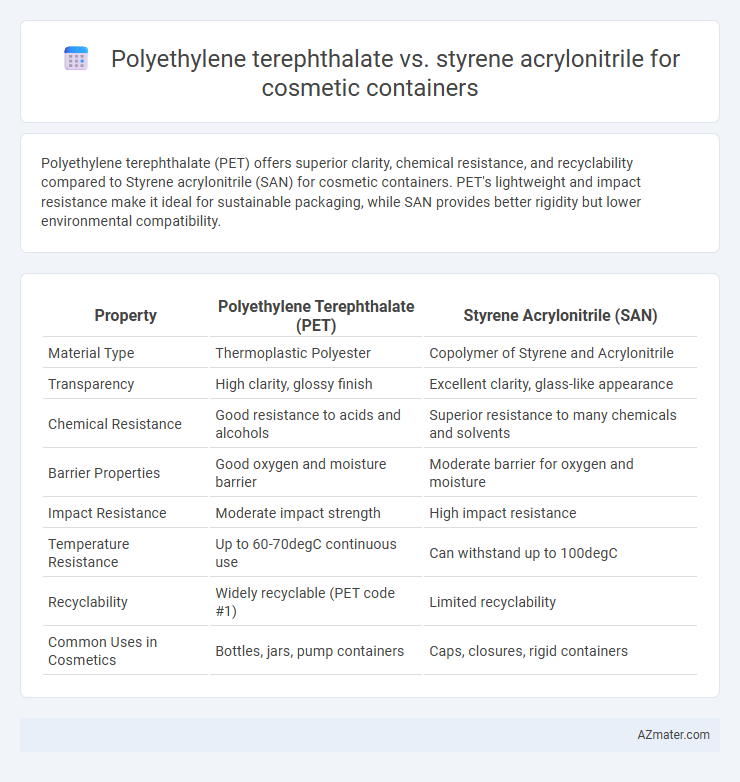Polyethylene terephthalate (PET) offers superior clarity, chemical resistance, and recyclability compared to Styrene acrylonitrile (SAN) for cosmetic containers. PET's lightweight and impact resistance make it ideal for sustainable packaging, while SAN provides better rigidity but lower environmental compatibility.
Table of Comparison
| Property | Polyethylene Terephthalate (PET) | Styrene Acrylonitrile (SAN) |
|---|---|---|
| Material Type | Thermoplastic Polyester | Copolymer of Styrene and Acrylonitrile |
| Transparency | High clarity, glossy finish | Excellent clarity, glass-like appearance |
| Chemical Resistance | Good resistance to acids and alcohols | Superior resistance to many chemicals and solvents |
| Barrier Properties | Good oxygen and moisture barrier | Moderate barrier for oxygen and moisture |
| Impact Resistance | Moderate impact strength | High impact resistance |
| Temperature Resistance | Up to 60-70degC continuous use | Can withstand up to 100degC |
| Recyclability | Widely recyclable (PET code #1) | Limited recyclability |
| Common Uses in Cosmetics | Bottles, jars, pump containers | Caps, closures, rigid containers |
Introduction: Importance of Material Choice in Cosmetic Containers
Choosing the right material for cosmetic containers is crucial for product preservation, safety, and consumer appeal. Polyethylene terephthalate (PET) offers excellent clarity, recyclability, and chemical resistance, making it ideal for high-end cosmetic packaging. Styrene acrylonitrile (SAN) provides superior rigidity and thermal stability but may fall short in sustainability compared to PET, affecting long-term brand positioning and environmental impact.
Overview of Polyethylene Terephthalate (PET)
Polyethylene terephthalate (PET) is a widely used thermoplastic polymer known for its excellent clarity, strong impact resistance, and lightweight properties, making it ideal for cosmetic containers. PET offers superior chemical resistance and moisture barrier capabilities, ensuring product integrity and extending shelf life in cosmetic packaging. Compared to Styrene acrylonitrile (SAN), PET provides enhanced recyclability and greater environmental sustainability, which aligns with growing consumer demand for eco-friendly packaging solutions.
Overview of Styrene Acrylonitrile (SAN)
Styrene Acrylonitrile (SAN) is a rigid, transparent thermoplastic widely used in cosmetic containers for its exceptional clarity and chemical resistance. SAN offers superior resistance to impact and solvents compared to Polyethylene Terephthalate (PET), making it ideal for packaging products requiring durability and aesthetic appeal. Its high stiffness and resistance to heat deformation enable secure storage of various formulations without compromising container integrity.
Mechanical Strength: PET vs SAN
Polyethylene terephthalate (PET) exhibits superior tensile strength and impact resistance compared to Styrene acrylonitrile (SAN), making it more suitable for cosmetic containers requiring durability and drop resistance. PET's mechanical properties include high stiffness and excellent fatigue resistance, which contribute to maintaining container integrity during transportation and daily use. In contrast, SAN offers good rigidity and chemical resistance but falls short in impact strength and flexibility, limiting its performance under mechanical stress.
Chemical Resistance and Compatibility
Polyethylene terephthalate (PET) exhibits excellent chemical resistance against most cosmetic ingredients, including oils, alcohols, and acids, making it highly compatible with a wide range of formulations. Styrene acrylonitrile (SAN) offers moderate chemical resistance but may degrade when exposed to strong solvents or acidic compounds commonly found in some cosmetic products. The superior barrier properties and chemical stability of PET make it a preferred choice for cosmetic containers requiring long-term preservation and product integrity.
Clarity and Aesthetic Appeal
Polyethylene terephthalate (PET) offers exceptional clarity and a glossy finish, making it highly favored for cosmetic containers that require a crystal-clear, polished appearance. Styrene acrylonitrile (SAN) provides good transparency but generally lacks the high-gloss, visually striking appeal of PET, resulting in a less vibrant presentation. PET's superior optical properties enhance product visibility and elevate brand perception through a sleek, modern aesthetic.
Barrier Properties: Protection Against Moisture and Oxygen
Polyethylene terephthalate (PET) offers superior barrier properties against moisture and oxygen, making it an ideal choice for cosmetic containers that require extended product shelf life and preservation. Styrene acrylonitrile (SAN), while providing moderate chemical resistance, generally exhibits lower moisture and oxygen barrier effectiveness compared to PET, which can compromise the stability of sensitive cosmetic formulations. PET's enhanced barrier performance helps maintain product integrity by minimizing exposure to environmental factors that cause degradation and spoilage.
Safety and Regulatory Compliance
Polyethylene terephthalate (PET) is widely favored in cosmetic containers due to its excellent chemical resistance, non-toxicity, and compliance with FDA and EU regulations for food and cosmetic packaging, ensuring consumer safety. In contrast, Styrene acrylonitrile (SAN) offers good clarity and rigidity but has more limited regulatory acceptance for cosmetic use because of potential styrene migration concerns under heat or prolonged storage. Choosing PET enhances safety and regulatory compliance by minimizing harmful leachables, making it the preferred material in cosmetic container manufacturing.
Environmental Impact and Recyclability
Polyethylene terephthalate (PET) offers superior recyclability for cosmetic containers due to its widespread acceptance in curbside recycling programs and high recovery rates, reducing environmental impact through efficient material reuse. In contrast, styrene acrylonitrile (SAN) poses greater challenges for recycling because of its specialized polymer composition, leading to limited recycling options and potentially higher ecological footprint. PET's lower carbon emissions during production and better biodegradability profile make it a more sustainable choice compared to SAN in cosmetic packaging applications.
Cost Analysis and Market Trends
Polyethylene terephthalate (PET) offers cost-effective production and superior recyclability compared to Styrene acrylonitrile (SAN), making it a preferred choice for cosmetic containers in price-sensitive markets. Market trends indicate increasing demand for sustainable packaging, driving growth in PET usage due to its lightweight and eco-friendly properties, while SAN maintains niche applications requiring chemical resistance and clarity. Price volatility in raw materials influences both polymers, but PET's established recycling infrastructure provides a competitive advantage in cost management and environmental compliance.

Infographic: Polyethylene terephthalate vs Styrene acrylonitrile for Cosmetic Container
 azmater.com
azmater.com